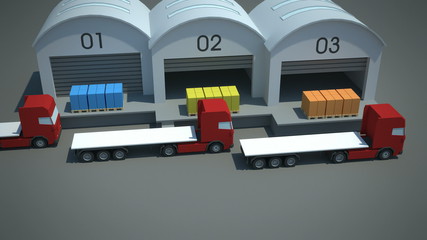In any distribution and fulfilment chain, warehousing is a large component and a costly proposition. In a distribution process, typically there is an incoming transport, and from there the goods are received and stored in a warehouse, and then again picked up for loading on to the outgoing transport bound for the desired destination. You incur charges for warehousing, and the process chain is lengthy.
What if you could eliminate the warehousing bit entirely, and just manage things cleverly so that the incoming goods already have their clients or destinations marked, and the logistics provider could pick up the goods and load them directly to the appropriate outgoing transport? It would completely eliminate the warehousing step, wouldn’t it?
The answer is yes, it is possible, and it is called cross-docking.
How is cross-docking different from traditional warehousing?
Cross-docking involves direct offloading and re-loading. The warehouse part is eliminated. But how’s it different from a process perspective, with respect to traditional warehousing?
In cross-docking the client is required to be pre-mapped to the incoming goods. And you need the services of a Third Party Logistics (3PL) Provider to manage the process of identifying the correct outgoing transport, and moving the goods directly from incoming to outgoing transport. The distributor has to manage multiple relationships with different agencies for picking, warehousing, and transporting. In the case of cross-docking, there are third party logistics (3PL) providers who will handle everything for you. This marks the major difference between cross-docking and warehousing.
The advantages of Cross-Docking over Warehousing
Advantage 1: Cost Reduction
As we mentioned at the beginning of this post, storing goods in a warehouse is costly. Warehouse rental costs can deliver an unpleasant shock, and should be minimized. In cross-docking you are eliminating or minimising the storing period, and therefore saving on the steep costs of warehousing.
Advantage 2: Improved Efficiency
In traditional warehousing, there are multiple parties involved in the process chain, like trucking partners, logistics partners, and parcel delivery. In cross-docking, you can do away with multiple partners and do with a single 3PL who can handle things end-to-end.
Advantage 3: Increased Reliability of Delivery
Since Cross-docking involves fewer human hands needed to handle the products, the risk of damage and human errors is minimized and this improves the prospects of receiving the products in good conditions and on time. Elimination of the warehousing step also improves the speed of delivery.
Advantage 4: Reduced Inventory
Since the stock is picked and directly shipped out to the clients, the inventory pileup in the warehouse is reduced, and this naturally translates to moving towards just in time inventory models which benefit everyone in the chain.
What’s right for me – cross-docking or warehousing?
Now we come to the all-important question: Should you adopt cross-docking? Is it suitable for your business? There are a few criteria which can be used, to answer this question very easily.
– Are you willing to invest the higher management attention and planning that cross-docking takes, as compared to warehousing?
– Do you have sufficiently large volumes that make cross-docking effective? Cross-docking is not efficient at low volume levels.
– Are you able to undergo the long lead time and capex needed to construct the cross-docking terminal structures?
– Are the products you are receiving, customer-ready? Or do they require further processing before they can be shipped to customers?
If your answer to the above questions is ‘yes’, then cross-docking is the way forward for you. Go right ahead!


2 thoughts on “The Difference Between Cross-docking and Warehousing”
One of the Nice Blog about warehousing activites
i like the explanation